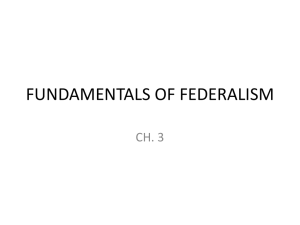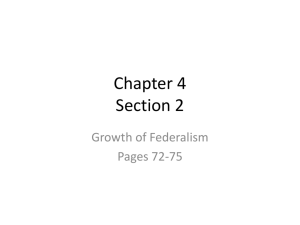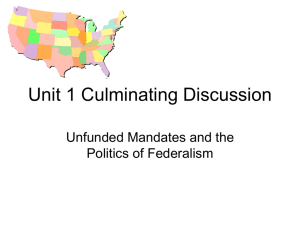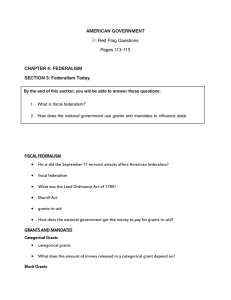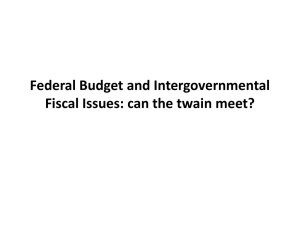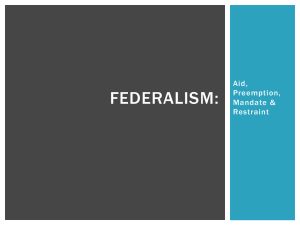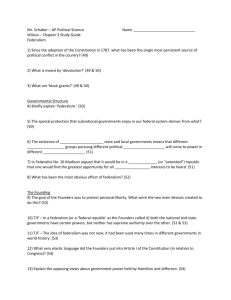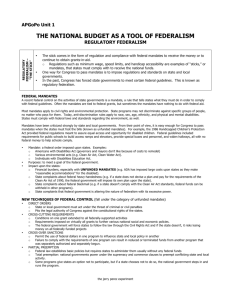Recent trends in Federalism File - Watford Grammar School for Boys
advertisement
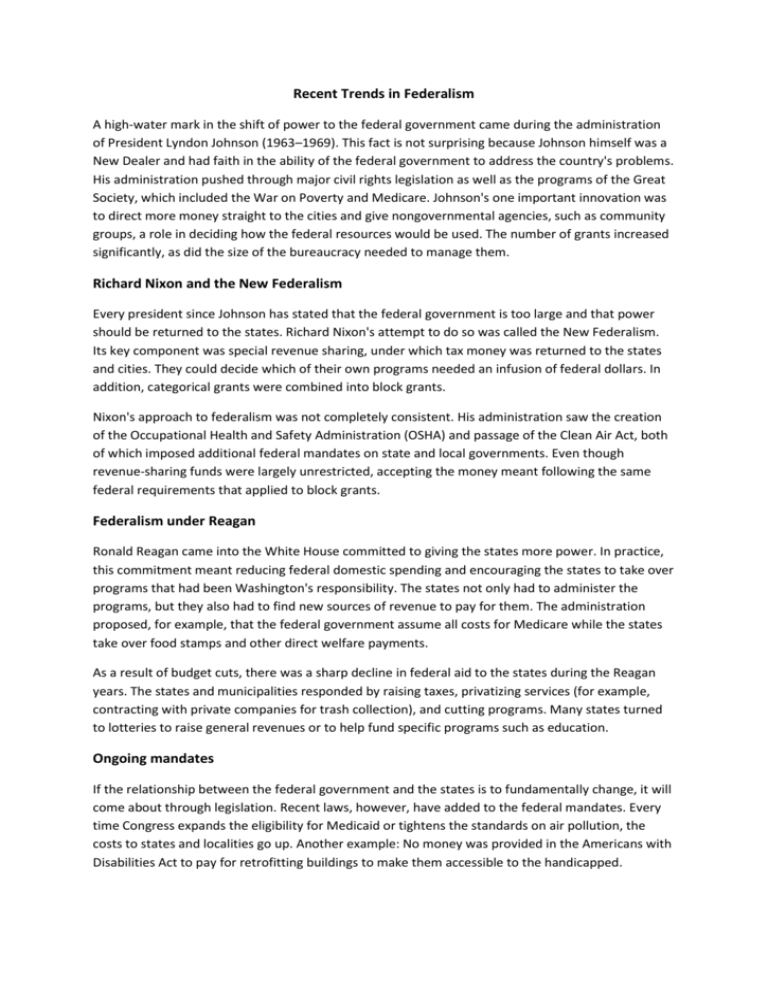
Recent Trends in Federalism A high-water mark in the shift of power to the federal government came during the administration of President Lyndon Johnson (1963–1969). This fact is not surprising because Johnson himself was a New Dealer and had faith in the ability of the federal government to address the country's problems. His administration pushed through major civil rights legislation as well as the programs of the Great Society, which included the War on Poverty and Medicare. Johnson's one important innovation was to direct more money straight to the cities and give nongovernmental agencies, such as community groups, a role in deciding how the federal resources would be used. The number of grants increased significantly, as did the size of the bureaucracy needed to manage them. Richard Nixon and the New Federalism Every president since Johnson has stated that the federal government is too large and that power should be returned to the states. Richard Nixon's attempt to do so was called the New Federalism. Its key component was special revenue sharing, under which tax money was returned to the states and cities. They could decide which of their own programs needed an infusion of federal dollars. In addition, categorical grants were combined into block grants. Nixon's approach to federalism was not completely consistent. His administration saw the creation of the Occupational Health and Safety Administration (OSHA) and passage of the Clean Air Act, both of which imposed additional federal mandates on state and local governments. Even though revenue-sharing funds were largely unrestricted, accepting the money meant following the same federal requirements that applied to block grants. Federalism under Reagan Ronald Reagan came into the White House committed to giving the states more power. In practice, this commitment meant reducing federal domestic spending and encouraging the states to take over programs that had been Washington's responsibility. The states not only had to administer the programs, but they also had to find new sources of revenue to pay for them. The administration proposed, for example, that the federal government assume all costs for Medicare while the states take over food stamps and other direct welfare payments. As a result of budget cuts, there was a sharp decline in federal aid to the states during the Reagan years. The states and municipalities responded by raising taxes, privatizing services (for example, contracting with private companies for trash collection), and cutting programs. Many states turned to lotteries to raise general revenues or to help fund specific programs such as education. Ongoing mandates If the relationship between the federal government and the states is to fundamentally change, it will come about through legislation. Recent laws, however, have added to the federal mandates. Every time Congress expands the eligibility for Medicaid or tightens the standards on air pollution, the costs to states and localities go up. Another example: No money was provided in the Americans with Disabilities Act to pay for retrofitting buildings to make them accessible to the handicapped. Unfunded mandates became a hot political issue in the early 1990s. The issue was not only legislative requirements but also the consequences of what were perceived to be failed national policies. For example, Governor Pete Wilson of California, who ran briefly for the 1996 Republican nomination for president, argued that the states should not have to pay for the inability of the federal government to control the nation's borders. California's expenses for illegal aliens and their children include welfare and public education. Congress passed the Unfunded Mandate Reform Act in 1995. It requires the Congressional Budget Office to determine the fiscal impact of unfunded mandates that exceed $50 million and provide this information to members of Congress before they vote on a bill. Where Americans stand Polls indicate that in a comparatively short time, there has been a significant change in the way Americans view the relationship between the states and the federal government. In 1994, almost three-quarters of the population believed that the federal government was too powerful. This number contrasts sharply with 1987 data, which showed fewer than half of all Americans taking this position. Less than 20 percent thought the balance between the states and the federal government was about right in 1994, whereas the largest group of people was satisfied with the balance just seven years earlier. The 1994 poll also showed that Americans viewed state and local government as better equipped than Washington to handle a variety of domestic issues, ranging from crime to welfare to transportation. Anti-Washington sentiment was a factor in the Republicans gaining control of Congress in 1994. Once in power, House Republicans put forward their own legislative agenda know as the Contract with America, which stressed returning power to the states. Even though Americans were roughly split on who could best tackle healthcare, President Bill Clinton's reform proposals failed to gain much headway, in part because they were seen as increasing the federal government's role. On welfare, however, the Clinton administration took another approach: The Personal Responsibility and Work Opportunity Reconciliation Act (1996), better known as the Welfare Reform Act, used block grants to transfer control of assistance to the poor from the federal government to the states. Although Republicans continued as the majority party in Congress during most of the Bush administration, the president expanded the federal role in an area traditionally left to states and local government. The No Child Left Behind Act (2001) placed new federal demands on public schools with the aim of improving student performance. Critics argue the requirements of the legislation came without adequate funding. During the 1990s, new federal mandates were limited unless money was also provided to cover them. For example, the benefits illegal immigrants are entitled to were curtailed. Despite these changes, immigration remains a volatile issue between the federal government, states, and localities. Washington is often blamed for lax enforcement of existing immigration laws — failing to secure the border or not cracking down on employers who hire illegal aliens. A number of cities across the country enacted ordinances prohibiting people in their communities from knowingly employing or renting housing to illegal immigrants; other cities declared themselves "safe havens" for the undocumented.

